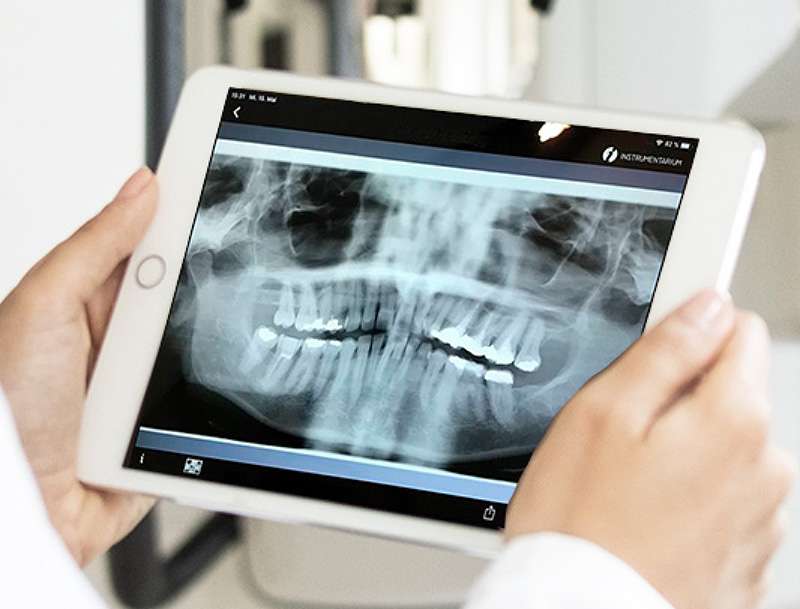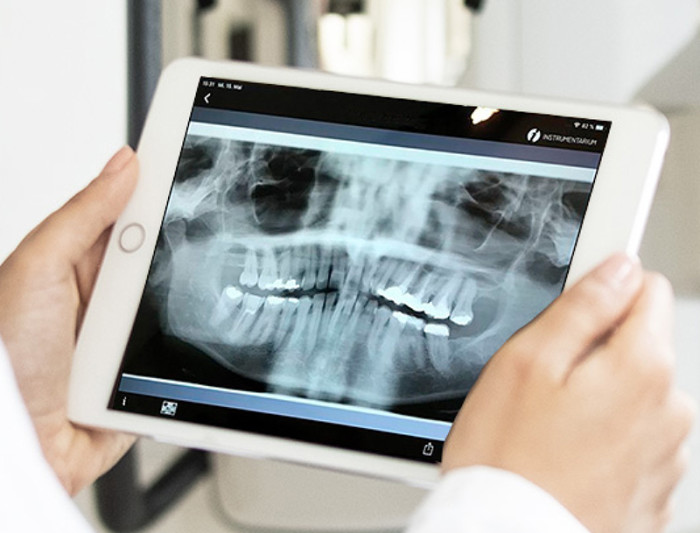Tooth decay: when bacteria attack the tooth enamel
When it comes to tooth decay, people often think of a hole in the tooth. However, this dental disease starts much earlier. If the affected teeth are not treated, not only will the enamel be permanently damaged, but teeth may also be lost. With the right measures, however, you can easily counteract the development of tooth decay.

What is tooth decay?
Tooth decay is a dental disease in which the substance of the tooth is destroyed. Acid-forming bacteria ensure decalcification or demineralisation of the hard tooth substance. If this process is not stopped, a hole will form in the tooth. Tooth decay is also known as caries; this word comes from the Latin and means something like rottenness or decay. The disease can also damage the nerves and roots of the teeth if it penetrates deeper cell layers. Ultimately, tooth decay can destroy teeth so badly that they have to be removed and replaced with a bridge or implant.
Types
There are a total of three different types of tooth decay or caries. The type indicates which area of the tooth is affected by the disease.
Dental neck caries: this type of tooth decay occurs on the surface of the tooth neck. Older adults are often affected, in particular, as they often suffer from receding gums.
Pit and fissure caries: this type of tooth decay affects the chewing surfaces of the molars. Food residues can easily accumulate in the hollows and niches of the tooth crown and, if the oral hygiene is inadequate, lead to multiplication of bacteria.
Surface caries: this type of tooth decay affects the smooth outer surfaces of the teeth. If bacteria are not removed, plaque forms, which, in turn, leads to the degradation of the tooth substance.
Initial stage to final stage
Before tooth decay occurs, so-called plaque – a thin layer of bacteria – forms on the teeth. If the plaque is not removed by regular brushing, it will multiply more and more. The bacteria convert carbohydrates like sugar from our food into acid, and this acid reacts with the calcium in our toothache. The result: the minerals are dissolved.
Tooth decay can be divided into four different stages:
Initial tooth decay is still a preliminary stage of tooth decay. The demineralisation of the tooth enamel has already started, and white, transparent or brownish spots appear on the tooth. Some of the damage can still be reversed here. However, if it remains untreated, tooth decay will occur.
Dentine caries or enamel caries shows up as significant defects in the tooth enamel. Food residues find it particularly easy to deposit here, and the progression of the dental disease is also accelerated. Brown spots can be clearly seen on the affected tooth.
Deep tooth decay has completely penetrated the tooth enamel. The bacteria have also already reached the dentin below, which is why toothache may occur for the first time. Bad breath can also occur at this stage. The stains on the tooth are brown to black.
Final stage: the final stage is decay of the tooth pulp, with an abscess in the tooth root. The dental disease has reached the sensitive pulp, and the roots of the teeth can become inflamed. The result is severe toothache. Treatment at the dentist is inevitable if you want to rule out any worse complications. In the worst case, the inflammation in the tooth can attack the jawbone and also trigger inflammation there. In addition, the bacteria can get into the bloodstream and, from the mouth, get throughout the body and damage other organs.
![Karies: Symptome, Stadien, Anwendung und Vorbeugung]()
Tooth decay or just discolouration: How can I recognise tooth decay?
If there are dark spots or even a hole in the tooth, it can be assumed that you are dealing with tooth decay, especially if combined with bad breath or toothache. If there is whitish or yellow discolouration, it is not entirely clear whether tooth decay is present. The first stage of tooth decay can usually only be recognised by a dentist, which is why you should have regular checkups. If discolouration occurs on the tooth, thorough oral hygiene can help. However, the areas should be monitored and, if necessary, examined by the dentist for absolute certainty.
What are the symptoms?
The first signs of tooth decay are whitish to brownish discoloration on the tooth. If the colour is yellow or brown, the enamel has already been attacked, so there is a hole. The symptoms express themselves here with sensitivity to cold, sweet or hot food and drinks and a susceptibility to pain. If the tooth enamel has been penetrated by the bacteria, and they have reached the dentin or pulp, bad breath and mild to severe toothache come on top. A sick tooth and toothache can weaken the body as a whole and be accompanied by headaches.
Overview of the symptoms of tooth decay.
Discolouration of the tooth: white, yellow, brown or black
Teeth are sensitive to pain
Bad breath
Toothache
Headache
Weakened body
Causes and risk factors
The causes of tooth decay are a high-sugar diet and poor oral hygiene. The preliminary stage of tooth decay is a layer of plaque made up of bacteria. If oral hygiene is neglected, the bacteria continue to multiply, and teeth decay. Caries bacteria convert carbohydrates, especially sugar, into acid, thereby demineralising the tooth enamel. If a lot of sugar is consumed, the harmful bacterial process accelerates. Other risk factors include neglecting regular checkups and professional teeth cleanings at the dentist. These allow tooth decay to be detected and eliminated early. A teeth cleaning will also clean hard-to-reach areas. But stress or smoking can also promote the development of tooth decay.
Overview of causes and risk factors:
Sugary foods and drinks
Poor oral hygiene
Missed checkup appointments at the dentist
No professional teeth cleaning
Stress
Smoking
Treatment at the dentist
If you have tooth decay, you cannot avoid treatment at the dentist. In the case of severe symptoms, especially, the affected tooth must be treated as quickly as possible in order to avoid worse consequences.
If the tooth decay is still in the initial stage, there is no need to drill, and the mineral loss can be compensated for by applying a fluoride varnish. The tooth surface will then be intact again.
In the classic treatment, tooth decay is removed by drilling the tooth, and the hole is sealed with an artificial filling made of amalgam or plastic. Thanks to modern anaesthesia, the treatment is not painful and takes between 30 minutes and 2 hours, depending on the filling. In the case of worse cases of tooth decay, however, there is also the threat of root canal treatment or loss of the tooth.
The costs for a classic treatment are covered by the statutory health insurance providers up to the amount of the costs for an amalgam filling. Any difference between this and a more expensive filling must be borne by the patient themselves.

Treating it yourself
Tooth decay is not something you can treat yourself, even just initial tooth decay However, a toothpaste containing fluoride and minerals from saliva can protect tooth enamel to some extent. If the tooth decay is at a later stage, no home remedies will help any more either, because once the tooth enamel has been broken through, the inside of the tooth is no longer protected. Treatment at the dentist is then inevitable.
Tooth decay in children
Tooth decay can already occur in babies and toddlers. The milk teeth are significantly softer than the second teeth, which is why the caries bacteria can quickly penetrate the tooth. Tooth decay in the milk teeth can also be transferred to the second teeth, which is why dental care from the first tooth onwards is very important. Children can also contract infections from their parents if, for example, they use the same spoon or lick the dummy. Tooth decay in children can be recognised by swollen gums or bleeding gums. A visit to the dentist can then provide certainty and initiate treatment.
Prevent tooth decay with proper oral hygiene and diet
Tooth decay can be prevented very well with thorough oral and dental care. In addition to brushing your teeth twice a day, this also includes using dental floss or interdental brushes, tongue cleaners and mouthwashes. This can stop the bacteria from multiplying. After eating, teeth should not be brushed until 30 minutes have passed. Professional tooth cleaning 1–2 times a year ensures that hard-to-reach areas get cleaned. Avoiding sugary foods and drinks can also counteract the development of tooth decay.
